Business Operations: Report on UK Business Practices
VerifiedAdded on 2020/09/17
|9
|1857
|59
Report
AI Summary
This report provides a comprehensive overview of business operations, encompassing various aspects such as the distinction between public and private sectors, different business structures, and the impact of economic environments. It delves into the significance of accounting, exploring its role in financial statement generation and stakeholder communication. The report also examines the functions of a Human Resource department, including recruitment, employee relations, compensation, and training. Furthermore, it provides insights into profit and loss accounts, team roles, training event components, and diverse leadership styles. The report utilizes a Barclays case study to illustrate the practical application of these concepts, offering valuable insights into business practices and strategies.
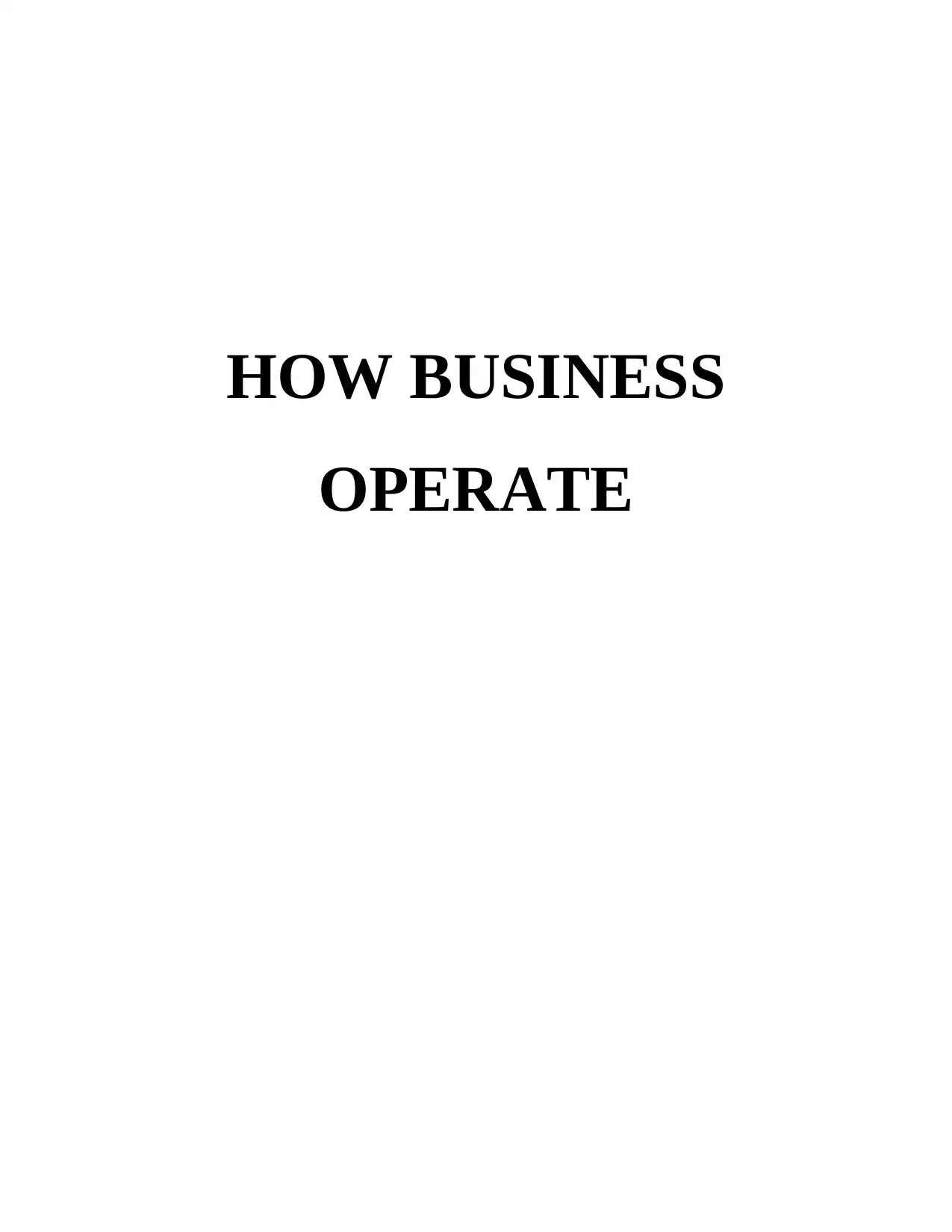
HOW BUSINESS
OPERATE
OPERATE
Paraphrase This Document
Need a fresh take? Get an instant paraphrase of this document with our AI Paraphraser
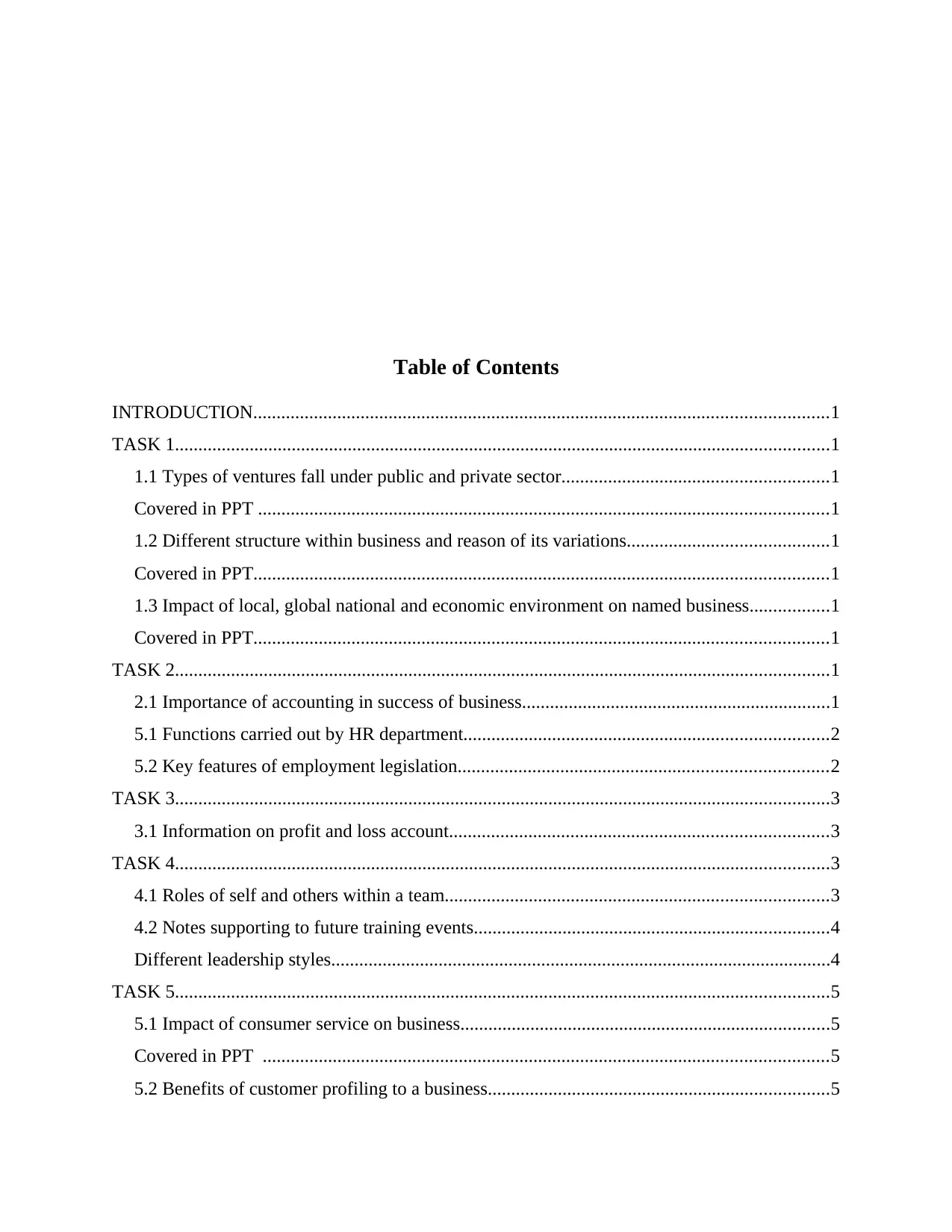
Table of Contents
INTRODUCTION...........................................................................................................................1
TASK 1............................................................................................................................................1
1.1 Types of ventures fall under public and private sector.........................................................1
Covered in PPT ..........................................................................................................................1
1.2 Different structure within business and reason of its variations...........................................1
Covered in PPT...........................................................................................................................1
1.3 Impact of local, global national and economic environment on named business.................1
Covered in PPT...........................................................................................................................1
TASK 2............................................................................................................................................1
2.1 Importance of accounting in success of business..................................................................1
5.1 Functions carried out by HR department..............................................................................2
5.2 Key features of employment legislation...............................................................................2
TASK 3............................................................................................................................................3
3.1 Information on profit and loss account.................................................................................3
TASK 4............................................................................................................................................3
4.1 Roles of self and others within a team..................................................................................3
4.2 Notes supporting to future training events............................................................................4
Different leadership styles...........................................................................................................4
TASK 5............................................................................................................................................5
5.1 Impact of consumer service on business...............................................................................5
Covered in PPT .........................................................................................................................5
5.2 Benefits of customer profiling to a business.........................................................................5
INTRODUCTION...........................................................................................................................1
TASK 1............................................................................................................................................1
1.1 Types of ventures fall under public and private sector.........................................................1
Covered in PPT ..........................................................................................................................1
1.2 Different structure within business and reason of its variations...........................................1
Covered in PPT...........................................................................................................................1
1.3 Impact of local, global national and economic environment on named business.................1
Covered in PPT...........................................................................................................................1
TASK 2............................................................................................................................................1
2.1 Importance of accounting in success of business..................................................................1
5.1 Functions carried out by HR department..............................................................................2
5.2 Key features of employment legislation...............................................................................2
TASK 3............................................................................................................................................3
3.1 Information on profit and loss account.................................................................................3
TASK 4............................................................................................................................................3
4.1 Roles of self and others within a team..................................................................................3
4.2 Notes supporting to future training events............................................................................4
Different leadership styles...........................................................................................................4
TASK 5............................................................................................................................................5
5.1 Impact of consumer service on business...............................................................................5
Covered in PPT .........................................................................................................................5
5.2 Benefits of customer profiling to a business.........................................................................5
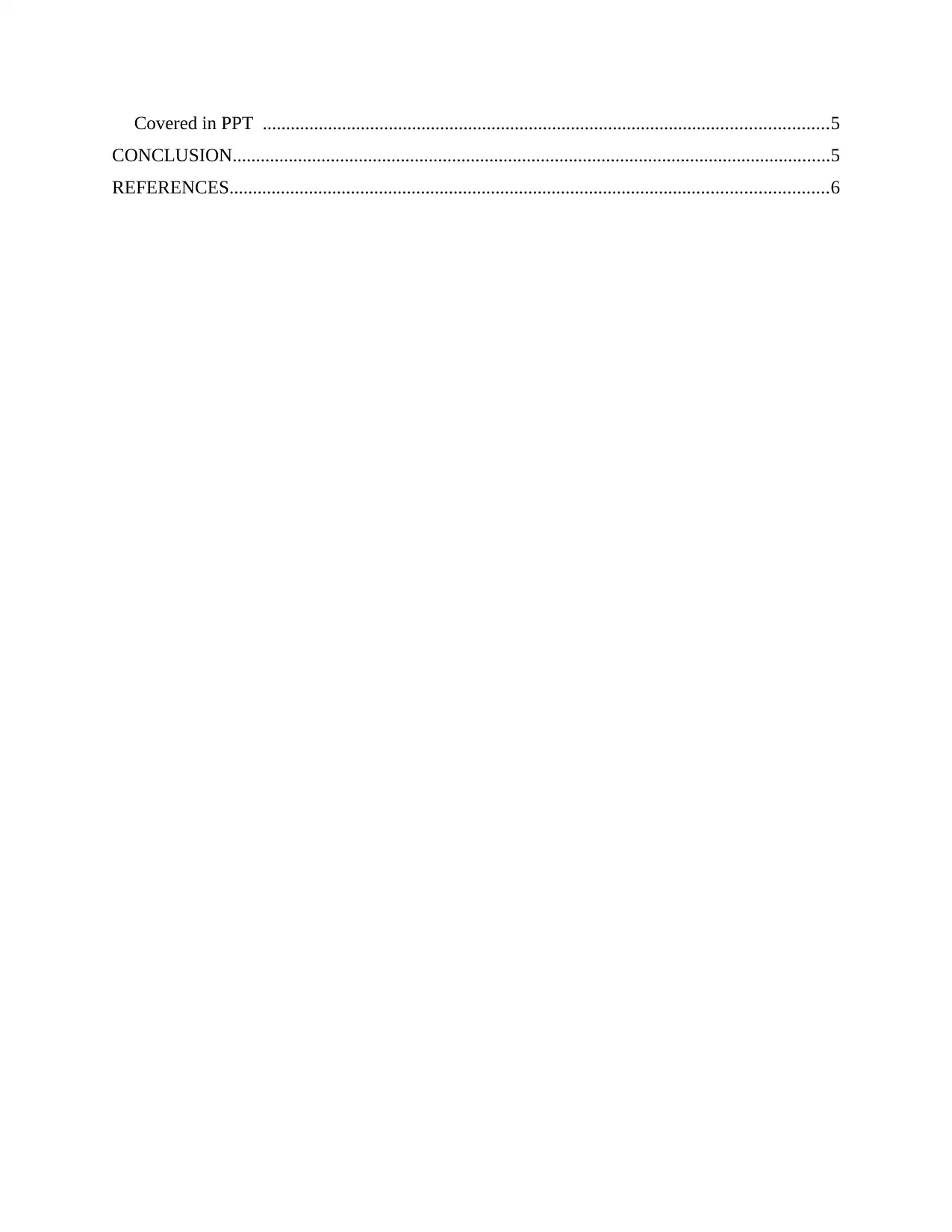
Covered in PPT .........................................................................................................................5
CONCLUSION................................................................................................................................5
REFERENCES................................................................................................................................6
CONCLUSION................................................................................................................................5
REFERENCES................................................................................................................................6
⊘ This is a preview!⊘
Do you want full access?
Subscribe today to unlock all pages.

Trusted by 1+ million students worldwide
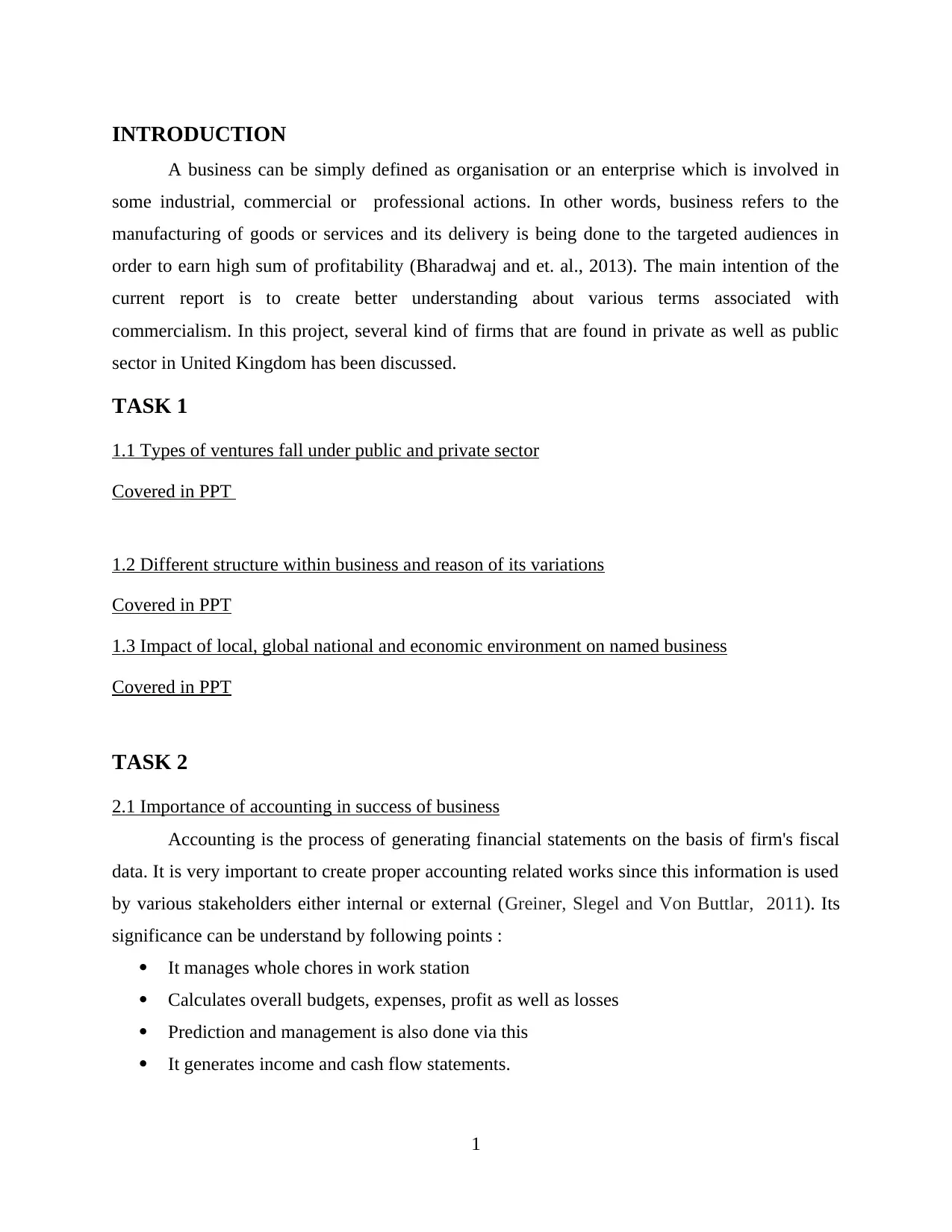
INTRODUCTION
A business can be simply defined as organisation or an enterprise which is involved in
some industrial, commercial or professional actions. In other words, business refers to the
manufacturing of goods or services and its delivery is being done to the targeted audiences in
order to earn high sum of profitability (Bharadwaj and et. al., 2013). The main intention of the
current report is to create better understanding about various terms associated with
commercialism. In this project, several kind of firms that are found in private as well as public
sector in United Kingdom has been discussed.
TASK 1
1.1 Types of ventures fall under public and private sector
Covered in PPT
1.2 Different structure within business and reason of its variations
Covered in PPT
1.3 Impact of local, global national and economic environment on named business
Covered in PPT
TASK 2
2.1 Importance of accounting in success of business
Accounting is the process of generating financial statements on the basis of firm's fiscal
data. It is very important to create proper accounting related works since this information is used
by various stakeholders either internal or external (Greiner, Slegel and Von Buttlar, 2011). Its
significance can be understand by following points :
It manages whole chores in work station
Calculates overall budgets, expenses, profit as well as losses
Prediction and management is also done via this
It generates income and cash flow statements.
1
A business can be simply defined as organisation or an enterprise which is involved in
some industrial, commercial or professional actions. In other words, business refers to the
manufacturing of goods or services and its delivery is being done to the targeted audiences in
order to earn high sum of profitability (Bharadwaj and et. al., 2013). The main intention of the
current report is to create better understanding about various terms associated with
commercialism. In this project, several kind of firms that are found in private as well as public
sector in United Kingdom has been discussed.
TASK 1
1.1 Types of ventures fall under public and private sector
Covered in PPT
1.2 Different structure within business and reason of its variations
Covered in PPT
1.3 Impact of local, global national and economic environment on named business
Covered in PPT
TASK 2
2.1 Importance of accounting in success of business
Accounting is the process of generating financial statements on the basis of firm's fiscal
data. It is very important to create proper accounting related works since this information is used
by various stakeholders either internal or external (Greiner, Slegel and Von Buttlar, 2011). Its
significance can be understand by following points :
It manages whole chores in work station
Calculates overall budgets, expenses, profit as well as losses
Prediction and management is also done via this
It generates income and cash flow statements.
1
Paraphrase This Document
Need a fresh take? Get an instant paraphrase of this document with our AI Paraphraser
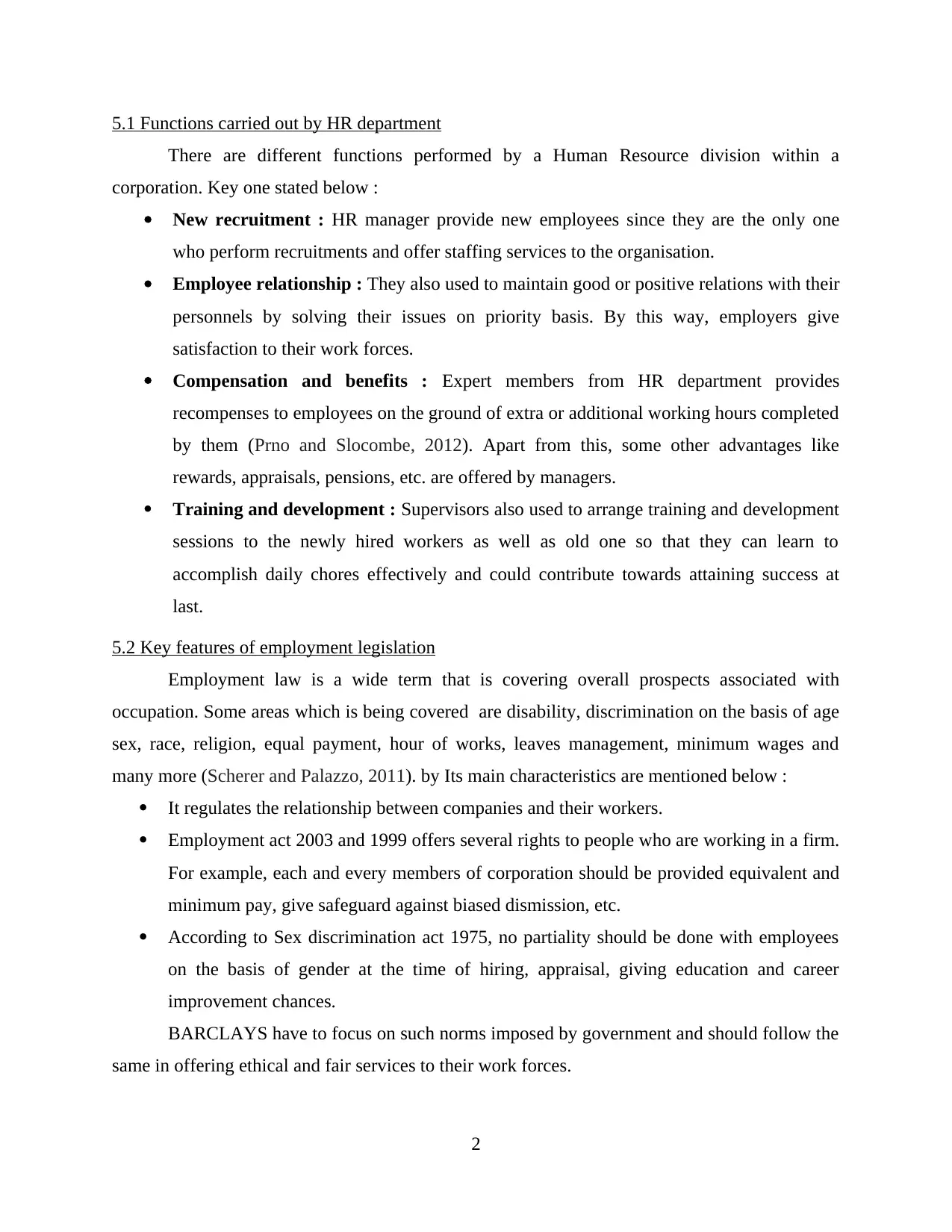
5.1 Functions carried out by HR department
There are different functions performed by a Human Resource division within a
corporation. Key one stated below :
New recruitment : HR manager provide new employees since they are the only one
who perform recruitments and offer staffing services to the organisation.
Employee relationship : They also used to maintain good or positive relations with their
personnels by solving their issues on priority basis. By this way, employers give
satisfaction to their work forces.
Compensation and benefits : Expert members from HR department provides
recompenses to employees on the ground of extra or additional working hours completed
by them (Prno and Slocombe, 2012). Apart from this, some other advantages like
rewards, appraisals, pensions, etc. are offered by managers.
Training and development : Supervisors also used to arrange training and development
sessions to the newly hired workers as well as old one so that they can learn to
accomplish daily chores effectively and could contribute towards attaining success at
last.
5.2 Key features of employment legislation
Employment law is a wide term that is covering overall prospects associated with
occupation. Some areas which is being covered are disability, discrimination on the basis of age
sex, race, religion, equal payment, hour of works, leaves management, minimum wages and
many more (Scherer and Palazzo, 2011). by Its main characteristics are mentioned below :
It regulates the relationship between companies and their workers.
Employment act 2003 and 1999 offers several rights to people who are working in a firm.
For example, each and every members of corporation should be provided equivalent and
minimum pay, give safeguard against biased dismission, etc.
According to Sex discrimination act 1975, no partiality should be done with employees
on the basis of gender at the time of hiring, appraisal, giving education and career
improvement chances.
BARCLAYS have to focus on such norms imposed by government and should follow the
same in offering ethical and fair services to their work forces.
2
There are different functions performed by a Human Resource division within a
corporation. Key one stated below :
New recruitment : HR manager provide new employees since they are the only one
who perform recruitments and offer staffing services to the organisation.
Employee relationship : They also used to maintain good or positive relations with their
personnels by solving their issues on priority basis. By this way, employers give
satisfaction to their work forces.
Compensation and benefits : Expert members from HR department provides
recompenses to employees on the ground of extra or additional working hours completed
by them (Prno and Slocombe, 2012). Apart from this, some other advantages like
rewards, appraisals, pensions, etc. are offered by managers.
Training and development : Supervisors also used to arrange training and development
sessions to the newly hired workers as well as old one so that they can learn to
accomplish daily chores effectively and could contribute towards attaining success at
last.
5.2 Key features of employment legislation
Employment law is a wide term that is covering overall prospects associated with
occupation. Some areas which is being covered are disability, discrimination on the basis of age
sex, race, religion, equal payment, hour of works, leaves management, minimum wages and
many more (Scherer and Palazzo, 2011). by Its main characteristics are mentioned below :
It regulates the relationship between companies and their workers.
Employment act 2003 and 1999 offers several rights to people who are working in a firm.
For example, each and every members of corporation should be provided equivalent and
minimum pay, give safeguard against biased dismission, etc.
According to Sex discrimination act 1975, no partiality should be done with employees
on the basis of gender at the time of hiring, appraisal, giving education and career
improvement chances.
BARCLAYS have to focus on such norms imposed by government and should follow the
same in offering ethical and fair services to their work forces.
2
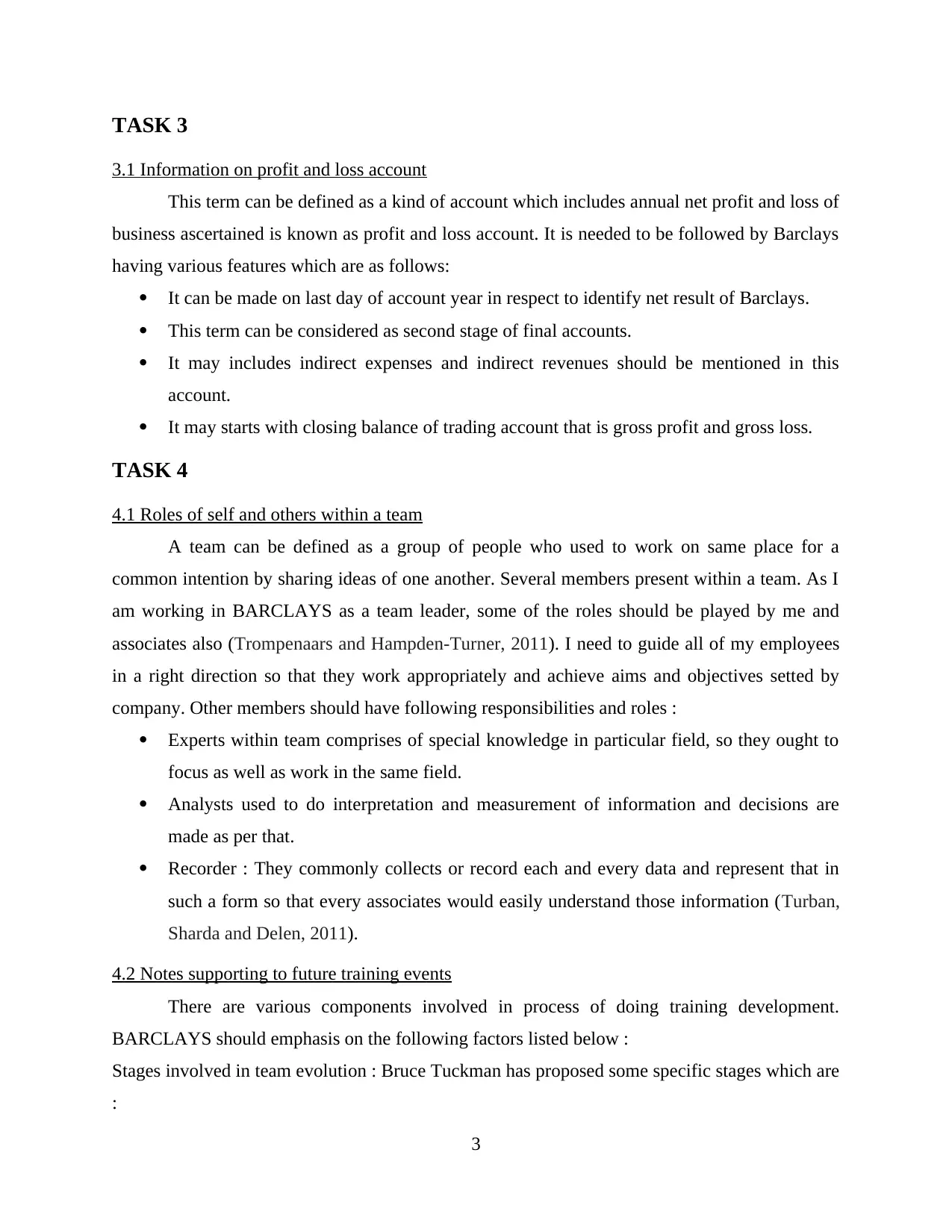
TASK 3
3.1 Information on profit and loss account
This term can be defined as a kind of account which includes annual net profit and loss of
business ascertained is known as profit and loss account. It is needed to be followed by Barclays
having various features which are as follows:
It can be made on last day of account year in respect to identify net result of Barclays.
This term can be considered as second stage of final accounts.
It may includes indirect expenses and indirect revenues should be mentioned in this
account.
It may starts with closing balance of trading account that is gross profit and gross loss.
TASK 4
4.1 Roles of self and others within a team
A team can be defined as a group of people who used to work on same place for a
common intention by sharing ideas of one another. Several members present within a team. As I
am working in BARCLAYS as a team leader, some of the roles should be played by me and
associates also (Trompenaars and Hampden-Turner, 2011). I need to guide all of my employees
in a right direction so that they work appropriately and achieve aims and objectives setted by
company. Other members should have following responsibilities and roles :
Experts within team comprises of special knowledge in particular field, so they ought to
focus as well as work in the same field.
Analysts used to do interpretation and measurement of information and decisions are
made as per that.
Recorder : They commonly collects or record each and every data and represent that in
such a form so that every associates would easily understand those information (Turban,
Sharda and Delen, 2011).
4.2 Notes supporting to future training events
There are various components involved in process of doing training development.
BARCLAYS should emphasis on the following factors listed below :
Stages involved in team evolution : Bruce Tuckman has proposed some specific stages which are
:
3
3.1 Information on profit and loss account
This term can be defined as a kind of account which includes annual net profit and loss of
business ascertained is known as profit and loss account. It is needed to be followed by Barclays
having various features which are as follows:
It can be made on last day of account year in respect to identify net result of Barclays.
This term can be considered as second stage of final accounts.
It may includes indirect expenses and indirect revenues should be mentioned in this
account.
It may starts with closing balance of trading account that is gross profit and gross loss.
TASK 4
4.1 Roles of self and others within a team
A team can be defined as a group of people who used to work on same place for a
common intention by sharing ideas of one another. Several members present within a team. As I
am working in BARCLAYS as a team leader, some of the roles should be played by me and
associates also (Trompenaars and Hampden-Turner, 2011). I need to guide all of my employees
in a right direction so that they work appropriately and achieve aims and objectives setted by
company. Other members should have following responsibilities and roles :
Experts within team comprises of special knowledge in particular field, so they ought to
focus as well as work in the same field.
Analysts used to do interpretation and measurement of information and decisions are
made as per that.
Recorder : They commonly collects or record each and every data and represent that in
such a form so that every associates would easily understand those information (Turban,
Sharda and Delen, 2011).
4.2 Notes supporting to future training events
There are various components involved in process of doing training development.
BARCLAYS should emphasis on the following factors listed below :
Stages involved in team evolution : Bruce Tuckman has proposed some specific stages which are
:
3
⊘ This is a preview!⊘
Do you want full access?
Subscribe today to unlock all pages.

Trusted by 1+ million students worldwide
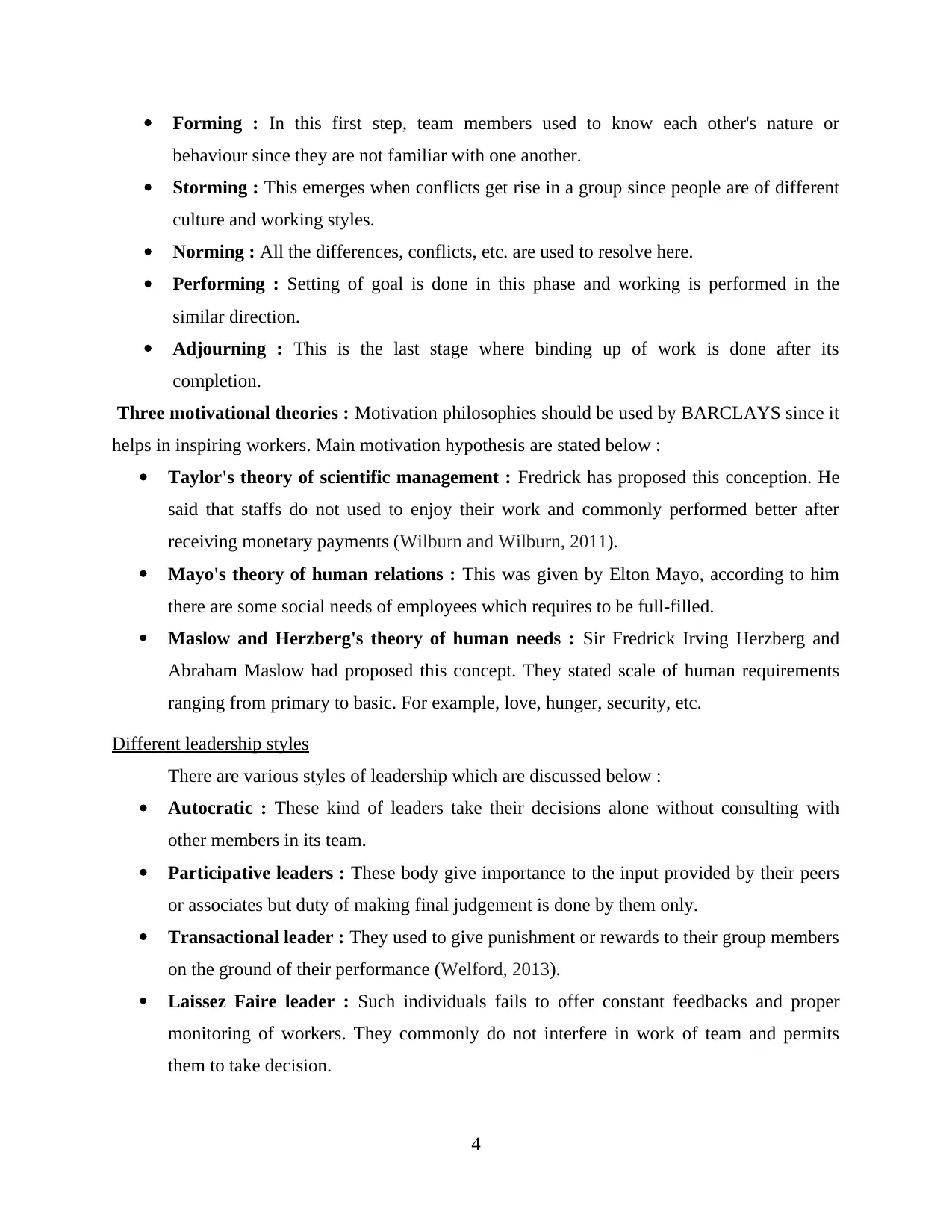
Forming : In this first step, team members used to know each other's nature or
behaviour since they are not familiar with one another.
Storming : This emerges when conflicts get rise in a group since people are of different
culture and working styles.
Norming : All the differences, conflicts, etc. are used to resolve here.
Performing : Setting of goal is done in this phase and working is performed in the
similar direction.
Adjourning : This is the last stage where binding up of work is done after its
completion.
Three motivational theories : Motivation philosophies should be used by BARCLAYS since it
helps in inspiring workers. Main motivation hypothesis are stated below :
Taylor's theory of scientific management : Fredrick has proposed this conception. He
said that staffs do not used to enjoy their work and commonly performed better after
receiving monetary payments (Wilburn and Wilburn, 2011).
Mayo's theory of human relations : This was given by Elton Mayo, according to him
there are some social needs of employees which requires to be full-filled.
Maslow and Herzberg's theory of human needs : Sir Fredrick Irving Herzberg and
Abraham Maslow had proposed this concept. They stated scale of human requirements
ranging from primary to basic. For example, love, hunger, security, etc.
Different leadership styles
There are various styles of leadership which are discussed below :
Autocratic : These kind of leaders take their decisions alone without consulting with
other members in its team.
Participative leaders : These body give importance to the input provided by their peers
or associates but duty of making final judgement is done by them only.
Transactional leader : They used to give punishment or rewards to their group members
on the ground of their performance (Welford, 2013).
Laissez Faire leader : Such individuals fails to offer constant feedbacks and proper
monitoring of workers. They commonly do not interfere in work of team and permits
them to take decision.
4
behaviour since they are not familiar with one another.
Storming : This emerges when conflicts get rise in a group since people are of different
culture and working styles.
Norming : All the differences, conflicts, etc. are used to resolve here.
Performing : Setting of goal is done in this phase and working is performed in the
similar direction.
Adjourning : This is the last stage where binding up of work is done after its
completion.
Three motivational theories : Motivation philosophies should be used by BARCLAYS since it
helps in inspiring workers. Main motivation hypothesis are stated below :
Taylor's theory of scientific management : Fredrick has proposed this conception. He
said that staffs do not used to enjoy their work and commonly performed better after
receiving monetary payments (Wilburn and Wilburn, 2011).
Mayo's theory of human relations : This was given by Elton Mayo, according to him
there are some social needs of employees which requires to be full-filled.
Maslow and Herzberg's theory of human needs : Sir Fredrick Irving Herzberg and
Abraham Maslow had proposed this concept. They stated scale of human requirements
ranging from primary to basic. For example, love, hunger, security, etc.
Different leadership styles
There are various styles of leadership which are discussed below :
Autocratic : These kind of leaders take their decisions alone without consulting with
other members in its team.
Participative leaders : These body give importance to the input provided by their peers
or associates but duty of making final judgement is done by them only.
Transactional leader : They used to give punishment or rewards to their group members
on the ground of their performance (Welford, 2013).
Laissez Faire leader : Such individuals fails to offer constant feedbacks and proper
monitoring of workers. They commonly do not interfere in work of team and permits
them to take decision.
4
Paraphrase This Document
Need a fresh take? Get an instant paraphrase of this document with our AI Paraphraser
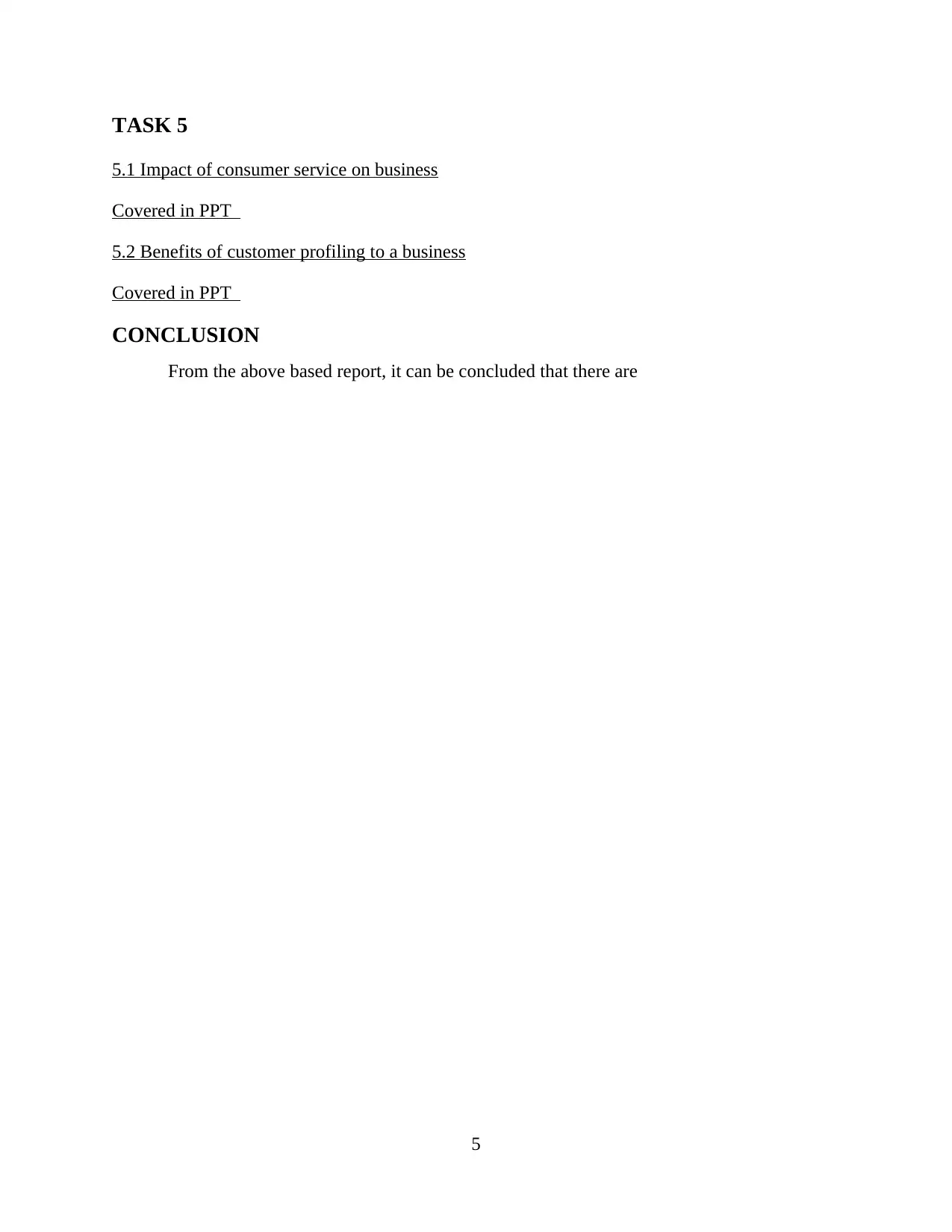
TASK 5
5.1 Impact of consumer service on business
Covered in PPT
5.2 Benefits of customer profiling to a business
Covered in PPT
CONCLUSION
From the above based report, it can be concluded that there are
5
5.1 Impact of consumer service on business
Covered in PPT
5.2 Benefits of customer profiling to a business
Covered in PPT
CONCLUSION
From the above based report, it can be concluded that there are
5
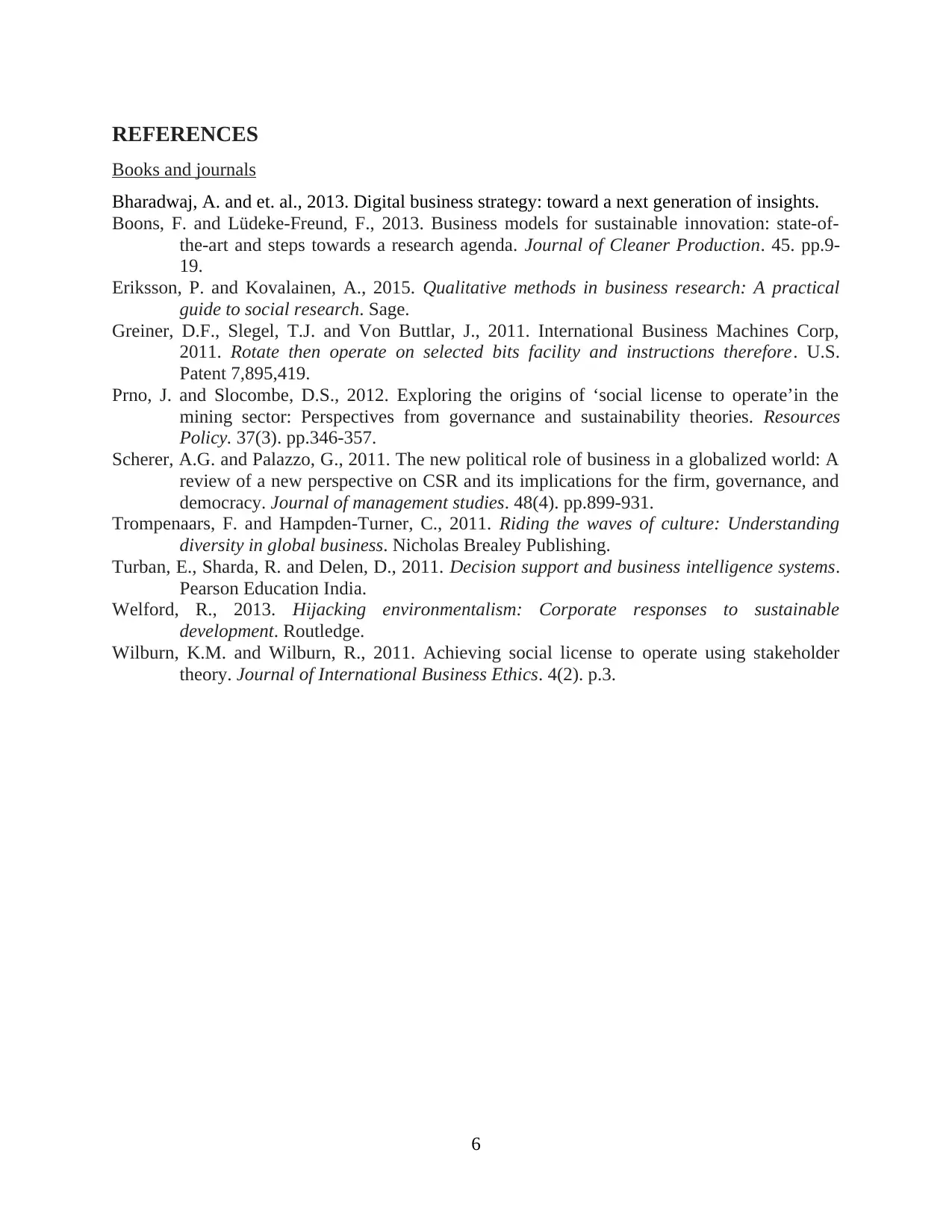
REFERENCES
Books and journals
Bharadwaj, A. and et. al., 2013. Digital business strategy: toward a next generation of insights.
Boons, F. and Lüdeke-Freund, F., 2013. Business models for sustainable innovation: state-of-
the-art and steps towards a research agenda. Journal of Cleaner Production. 45. pp.9-
19.
Eriksson, P. and Kovalainen, A., 2015. Qualitative methods in business research: A practical
guide to social research. Sage.
Greiner, D.F., Slegel, T.J. and Von Buttlar, J., 2011. International Business Machines Corp,
2011. Rotate then operate on selected bits facility and instructions therefore. U.S.
Patent 7,895,419.
Prno, J. and Slocombe, D.S., 2012. Exploring the origins of ‘social license to operate’in the
mining sector: Perspectives from governance and sustainability theories. Resources
Policy. 37(3). pp.346-357.
Scherer, A.G. and Palazzo, G., 2011. The new political role of business in a globalized world: A
review of a new perspective on CSR and its implications for the firm, governance, and
democracy. Journal of management studies. 48(4). pp.899-931.
Trompenaars, F. and Hampden-Turner, C., 2011. Riding the waves of culture: Understanding
diversity in global business. Nicholas Brealey Publishing.
Turban, E., Sharda, R. and Delen, D., 2011. Decision support and business intelligence systems.
Pearson Education India.
Welford, R., 2013. Hijacking environmentalism: Corporate responses to sustainable
development. Routledge.
Wilburn, K.M. and Wilburn, R., 2011. Achieving social license to operate using stakeholder
theory. Journal of International Business Ethics. 4(2). p.3.
6
Books and journals
Bharadwaj, A. and et. al., 2013. Digital business strategy: toward a next generation of insights.
Boons, F. and Lüdeke-Freund, F., 2013. Business models for sustainable innovation: state-of-
the-art and steps towards a research agenda. Journal of Cleaner Production. 45. pp.9-
19.
Eriksson, P. and Kovalainen, A., 2015. Qualitative methods in business research: A practical
guide to social research. Sage.
Greiner, D.F., Slegel, T.J. and Von Buttlar, J., 2011. International Business Machines Corp,
2011. Rotate then operate on selected bits facility and instructions therefore. U.S.
Patent 7,895,419.
Prno, J. and Slocombe, D.S., 2012. Exploring the origins of ‘social license to operate’in the
mining sector: Perspectives from governance and sustainability theories. Resources
Policy. 37(3). pp.346-357.
Scherer, A.G. and Palazzo, G., 2011. The new political role of business in a globalized world: A
review of a new perspective on CSR and its implications for the firm, governance, and
democracy. Journal of management studies. 48(4). pp.899-931.
Trompenaars, F. and Hampden-Turner, C., 2011. Riding the waves of culture: Understanding
diversity in global business. Nicholas Brealey Publishing.
Turban, E., Sharda, R. and Delen, D., 2011. Decision support and business intelligence systems.
Pearson Education India.
Welford, R., 2013. Hijacking environmentalism: Corporate responses to sustainable
development. Routledge.
Wilburn, K.M. and Wilburn, R., 2011. Achieving social license to operate using stakeholder
theory. Journal of International Business Ethics. 4(2). p.3.
6
⊘ This is a preview!⊘
Do you want full access?
Subscribe today to unlock all pages.

Trusted by 1+ million students worldwide
1 out of 9
Related Documents
Your All-in-One AI-Powered Toolkit for Academic Success.
+13062052269
info@desklib.com
Available 24*7 on WhatsApp / Email
![[object Object]](/_next/static/media/star-bottom.7253800d.svg)
Unlock your academic potential
Copyright © 2020–2025 A2Z Services. All Rights Reserved. Developed and managed by ZUCOL.





